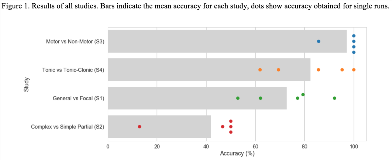Automatic Epileptic Seizure Type Classification Using Deep Neural Networks
Abstract number :
3.174
Submission category :
4. Clinical Epilepsy / 4A. Classification and Syndromes
Year :
2018
Submission ID :
502615
Source :
www.aesnet.org
Presentation date :
12/3/2018 1:55:12 PM
Published date :
Nov 5, 2018, 18:00 PM
Authors :
Isabell Kiral-Kornek, IBM Research Australia; Subhrajit Roy, IBM Research Australia; and Stefan Harrer, IBM Research Australia
Rationale: Epilepsy is a family of neurological conditions that cause recurrent, irregular, and seemingly unpredictable seizures. The way in which a specific seizure manifests itself in a patient is referred to as its type [1]. Epileptic seizure type impacts the choice of drugs as well as the range of activities a patient can safely engage in. Recent advances toward artificial intelligence enabled automatic seizure detection [2] lay the basis for long-term monitoring systems that track seizure frequency, duration, and severity. The inclusion of seizure type is the next logical step towards a fully-automated seizure diary and is the focus of this work. Creating automatic records of seizure frequency, duration, severity, and type will play an integral role for disease management of an epileptic patient and will help in conducting clinical trials to test new treatments. Methods: A subset of a dataset known as the TUH Seizure Corpus [3] was used. This corpus contains type-labelled electroencephalography (EEG) recording sessions of 125 patients, using 21 channels, collected in the standard 10/20 configuration at 250 Hz. Seizure types can be described through their onset location (generalized or focal) or their symptomatic manifestation. The dataset used contained exactly one class per seizure event, not necessarily giving an indication of the onset location when the symptom was described and vice versa. Hence, the data allowed us to classify either along the mechanistic or symptomatic axis in four separate studies: Study 1 Generalized vs. focal seizure onset. Study 2 Complex partial vs. simple partial seizure. Study 3 Motor vs. non-motor seizures. Study 4 Tonic-clonic vs. tonic seizures. Following standardized pre-processing, we built four binary classifiers, using the convolutional neural network architecture described in Table 1. All results were obtained using 5-fold cross validation. Results: Resulting accuracies are summarized in Figure 1. Statistically significant difference from chance level (p<0.01) was obtained for studies 1 (generalized vs. focal seizures), 3 (motor vs. non-motor seizures), and 4 (tonic vs. tonic-clonic seizures), with accuracies of 72.7%(±15.4%), 82.4%(±16.4%), and 97.1%(±6.4%), respectively. Our algorithm was not able to distinguish complex partial from simple partial seizures. Conclusions: This proof-of-concept study shows the feasibility of automatic seizure type classification as a second step after successful seizure detection. The successful combination of normal/abnormal classification, seizure detection, and type classification into a fully automated seizure detection system will support a shorter time to diagnosis and better treatment of epilepsy. In addition, an automatic mobile seizure detection and classification device may improve long-term patient care, enabling timely drug adjustments, remote monitoring, and aid in clinical trials. Accurate seizure type classification may furthermore impact the performance of deep-learning enabled seizure prediction systems [4,5].[1] Fisher RS et al., Epilepsia. 2017;58(4):531–542.[2] Golmohammadi M, et al. arxiv171209776 cs eess q-bio stat, Dec. 2017.[3] Obeid I and Picone J. Front Neurosci. May 2016.[4] Kiral-Kornek I, Roy S. et al.Epileptic seizure prediction using big data and deep learning: toward a mobile system. EBioMedicine (The Lancet). Dec. 2017.[5] Kiral-Kornek I, Roy S et al. AES 2017. Funding: All authors are employed by IBM Research Australia

.tmb-.png?Culture=en&sfvrsn=64d78bd1_0)